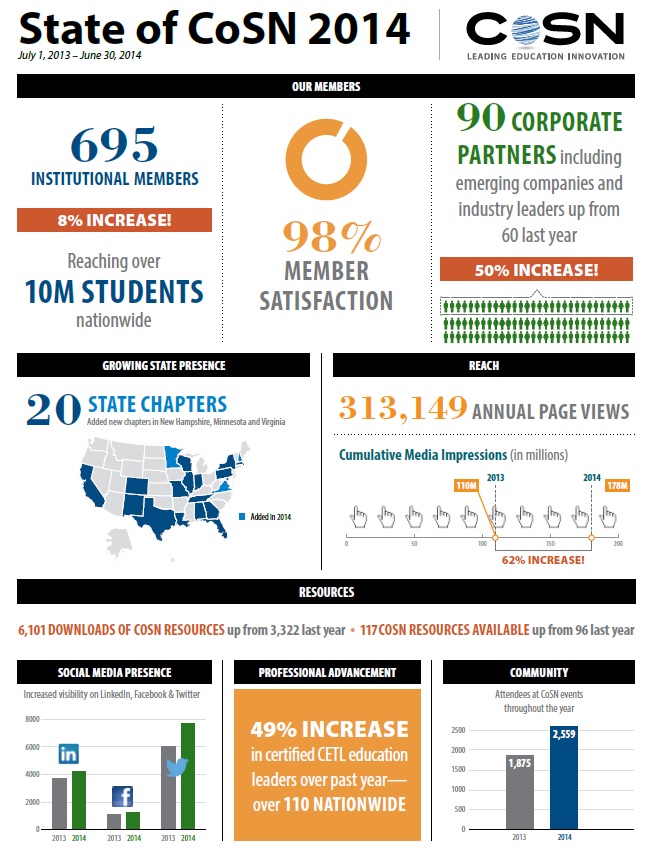CoSN (the Consortium for School Networking) has released their latest 2015 Ed Tech Next report “Dimensions in Learning: Visualizing, Designing, and Making in 3D.” The report focuses on the growth and potential of 3D in education.

“Visualizing, designing and making in 3D are our future.”
– Ed Tech Next 2015 Report
CoSN is a leading international professional association for district technology leaders. For those unfamiliar with CoSN (headquartered in Washington, D.C.), the infographic below will help explain its reach and membership:

CoSN represents over 10 million students in school districts nationwide and is a powerful and influential voice in K-12 education.
Once or twice a year, CoSN releases its well-respected Ed Tech Next report. Ed Tech Next reports are periodic publications which examine hot emerging technologies. Designed for busy professionals, these reports provide quick snapshots of rapidly changing fields, followed by succinct summaries of the issues as well as discussion questions or case studies to guide organizational thinking. CoSN’s EdTechNext reports are supported by a pantheon of companies: Amplify, BestBuy, CDW.G, Cisco, Comcast, Dell, ENA, Filewave, Google, HP, iBoss Security, iDentityAutomation, Ipswitich, itslearning, JAMF Software, Juniper Networks, Lenovo, Lightspeed Systems, McGraw Hill, Microsoft, Pearson, Presidio, Promethean, Qualcomm, SchoolDude, Sprint and Verizon.
The first report of 2015 focuses on 3D in education. (In bringing full disclosure to the table, I am one of the two co-authors of this report. The other author is Chad Norman, who serves as the K-12 Highly Capable Program Director for the Mount Vernon School District in Washington state.) The report, as the title indicates, focuses on the three “learning families” of 3D in education: designing in 3D, visualizing in 3D and making in 3D. Each of these components is supported in some measure by the projector, large display and mobile display technology industry.
The report suggests that 3D technologies sit at the bedrock of the coming digital learning revolution:
[The same] struggles and achievements mark the progress of civilization. People observe, conceptualize and understand, laboring to think, plan, design and solve and struggling to fix, build, tear down, retool, reinvent – and do it all again. The digital revolution has not lessened our ingrained desire to understand, interact with and challenge the immersive world. In fact, these age-old strivings continue as we use new digital environments to visualize, design and construct our way through life, learning and work. Enter 3D technologies. 3D – originally a trademark of the artisan’s stall, the architect’s bench, the gamer’s console, the blockbuster cinema or the engineer’s display – is rapidly moving to the newest sandbox for learning, hashtag, the digital classroom.
The report claims that 3D merits consideration for its educational value proposition, not its “wow” factor. “In other words, what matters is the potential for improved learning with 3D technologies, not merely the pizzazz of 3D visualization, design or printed objects”. The report then goes on to cite recent research indicating the benefits of 3D technologies for visualizing, designing and making; highlights numerous industry players in the world of 3D in education; and provides a rich list of available resources and references. – Len Scrogan
To obtain more information about this report, or to explore CoSN membership, see http://www.cosn.org/ed-tech-next-reports

